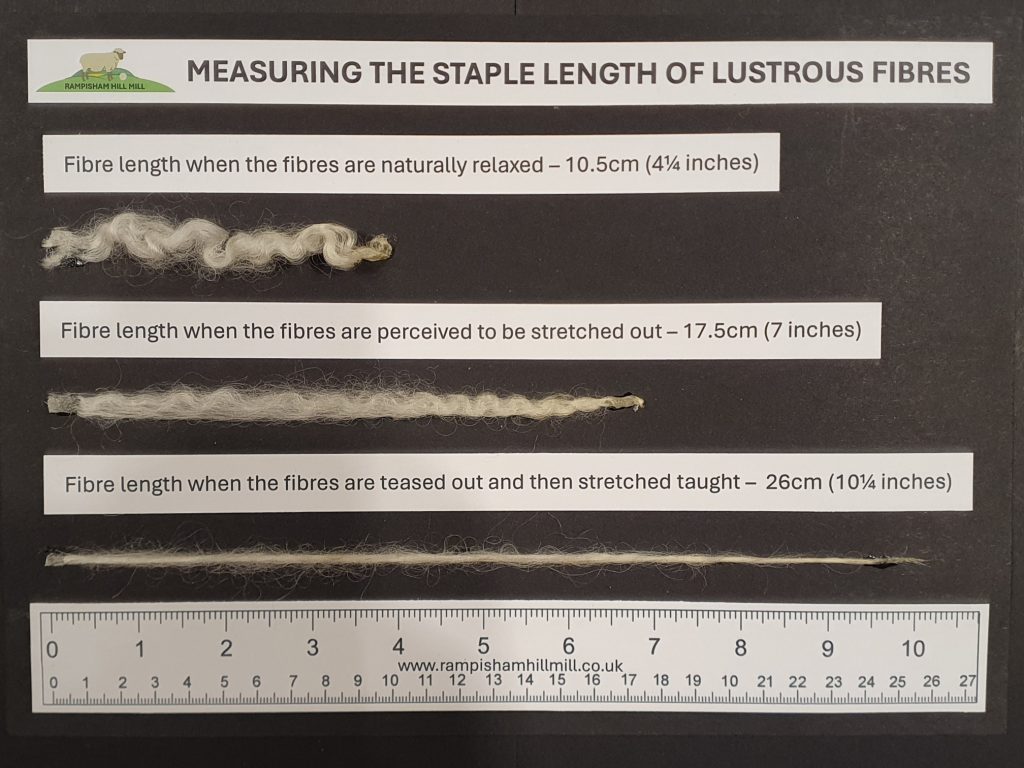Measuring the staple length of your fibre correctly is paramount, as it can dictate which processing options will be available for you and your type of fibre. It is particularly important that this measurement is done accurately for lustrous breeds such as: Cotswold, Gotland, Romney, Teeswater, Wensleydale, Leicester Longwool, Lincoln Longwool, Valais Blacknose, Grey Faced Dartmoor, Devon & Cornwall Longwool, as well as cross breeds with longer fibres etc.

When we ask for the staple length of your fibre we need the length of those fibres when they are fully teased out and then stretched taut. As you can see from the photograph above, which is of some Wensleydale fibre, there is an 8.5cm (3½ inch) difference between the ‘perceived to be’ stretched fibre example measurement of 17.5cm (7 inch) and the true fibre staple length which is actually 26cm (10 ¼ inch) when fully teased out taut, as seen in the bottom example.
When asked, customers would typically tell us the staple length of this example Wensleydale fibre is 17.5cm (7 inch), however you can see there are still a lot of visible loops and curls of individual fibres running within the lock, as even though a few of the shorter fibres look parallel and might be stretched taut, the majority are not, hence the much lower staple length measurement.
TOP TIPS FOR MAKING ACCURATE MEASUREMENTS OF STAPLE LENGHT
To measure your fibre’s staple length accurately please randomly select a few locks from various parts of the fleece or consignment.
Find at least a 30cm (12 inch) ruler or a tape measure and put it flat on a surface ready to take a measurement after you have prepared your fibre.
Get a small clump of one of those locks, holding the tip firmly between your fingers, gently tease those individual fibres out of the lock by running your other hand down the lock from top to bottom while keeping hold of the tip. You might have to repeat this a few times to really get tease out the ‘tangles’ and end up with smooth parallel fibres. Some fibre breakage is inevitable while you are doing this and these might then ‘recoil’ back into their original shape, but try to keep it to a minimum as you want the longest fibres possible. You can see in the bottom example above that there are still a few curls where the shorter fibres within have recoiled as they are not being held at both ends, but the longer fibres are now parallel and held taut.
Once you have a drawn out the fibres from the lock satisfactorily, hold the tip again and then, gently slide your other hand down lightly pinching the fibre as to keep a little bit of tension on the fibres, do this until you are just holding them by the very ends, then while the fibre is still taut take a measurement on your ruler or tape measure, remembering to include the bit of fibre held in between your fingers!
It is good practice to repeat this exercise for locks from different parts of the fleece or the consignment as this will then give an average staple length and a maximum staple length of that fleece or consignment.
Once you get the hang of the technique it doesn’t take long to take the measurements, but it will really help us to help you if you can supply an accurate staple length. If you have any questions regarding measuring your fibre then please do not hesitate to contact us.